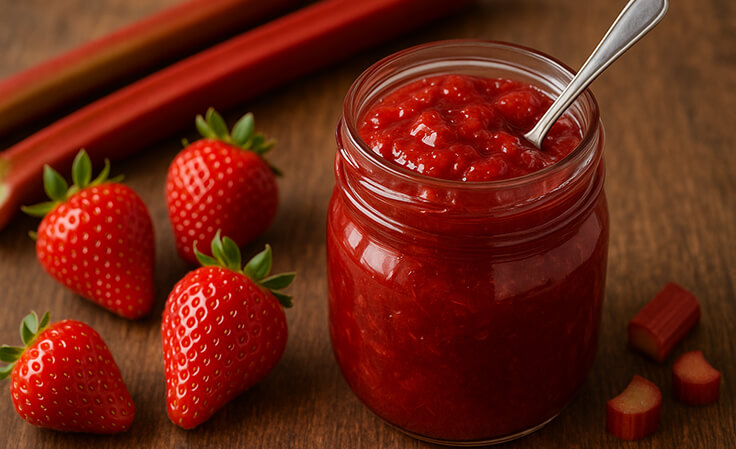There’s something undeniably nostalgic about the sweet-tart smell of simmering strawberries and rhubarb wafting through the kitchen. On my homestead, this jam is a seasonal must—especially when the garden is overflowing and I want to preserve that vibrant, sun-ripened flavor for the months ahead. Whether you’re new to canning or a seasoned pro, this old-fashioned strawberry rhubarb jam recipe is one you’ll come back to again and again.
Why Make Homemade Strawberry Rhubarb Jam?
Store-bought jams can’t compete with the flavor—and they often come with added preservatives, high-fructose corn syrup, or synthetic pectin. This jam recipe is made with simple, natural ingredients and doesn’t use any boxed pectin. The natural pectin in the fruit and lemon juice is all you need.
This recipe is perfect for:
- Beginner canners
- Families looking to stock their pantry with real food
- Anyone who wants to ditch processed jams and embrace seasonal preservation

Homemade Strawberry Rhubarb Jam
Ingredients
- 4 cups chopped fresh strawberries (hulled)
- 4 cups chopped rhubarb (trimmed)
- 3 cups organic cane sugar (or raw sugar)
- 2 tbsp freshly squeezed lemon juice
- 1 tbsp lemon zest (optional but recommended)
Instructions
- Prepare Your Ingredients: Wash and chop the strawberries and rhubarb into bite-sized pieces. You want them small enough to break down easily during cooking but large enough to keep some texture.
- Macerate the Fruit: In a large non-reactive bowl, combine the strawberries, rhubarb, sugar, and lemon juice. Stir until everything is evenly coated. Cover and let sit at room temperature for at least 2–3 hours (or overnight in the fridge). This draws out the juices and helps the sugar dissolve naturally.
- Cook the Jam: Pour the fruit mixture into a heavy-bottomed pot. Bring to a simmer over medium heat, stirring frequently to prevent burning. Let it simmer gently for 30–40 minutes, continuing to stir often. The jam will foam up—that’s normal. You can skim off the foam if you prefer.
- Test for Doneness: When the mixture thickens and reduces, test it by placing a spoonful on a cold plate and dragging your finger through it. If it holds the line, it’s ready. You can also use a thermometer—look for 220°F for proper gelling.
- Jar It Up: Pour the hot jam into sterilized jars, leaving 1/4-inch headspace. Wipe rims, apply lids and rings, and process in a boiling water bath for 10 minutes (adjust for altitude).
How to Store Homemade Jam
Once processed, store your jars in a cool, dark place. They’ll last unopened for up to a year. Once opened, keep refrigerated and use within a few weeks. You can also freeze this jam if you prefer not to can it.
Tips from My Homestead Kitchen
- Skip the store-bought pectin. The lemon juice and natural fruit sugars do all the thickening work. Plus, it means fewer ingredients and a more traditional texture.
- Use raw or organic sugar for a richer, deeper flavor that complements the tart rhubarb beautifully.
- Don’t overcook. Overcooking can break down the natural pectin and leave your jam runny. Watch carefully once it starts to thicken.
- Small batch = less stress. If you’re new to preserving, this manageable recipe helps you build confidence in the kitchen without feeling overwhelmed.
Serving Suggestions
This jam is incredibly versatile:
- Spread it over sourdough toast or warm biscuits
- Swirl it into plain yogurt or oatmeal
- Use it as a filling for hand pies or thumbprint cookies
- Serve it alongside cheese and crackers on a rustic snack board
On my homestead, we often spoon it over pancakes with a dollop of raw cream or use it to flavor homemade kefir. The possibilities are endless when you’re working with real, whole ingredients.
Why I Love Seasonal Preserving
Strawberry rhubarb jam reminds me that food is meant to be savored and that the act of preserving is more than just stocking a pantry. It’s a lifestyle rooted in intention, self-reliance, and nourishing your family with the harvest. Even if you’re living in an apartment or on a small lot, you can take a step toward that lifestyle with recipes like this.
If you’re serious about building your own pantry of homemade preserves, my Canning Journal is the perfect tool to help you track every batch, ingredient, and seal. I created it to make preserving simpler, more organized, and stress-free. Grab your copy today and start preserving with confidence.
The beauty of this recipe is how adaptable it is. Want it less sweet? Reduce the sugar. Like a smoother texture? Use an immersion blender at the end. You can even add in vanilla bean or a dash of cinnamon for a unique twist.
Making strawberry rhubarb jam from scratch is one of the simplest, most rewarding ways to embrace homestead living no matter where you are.
